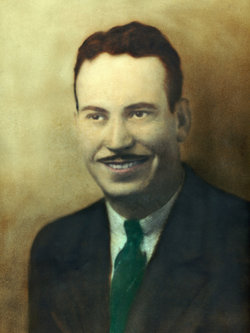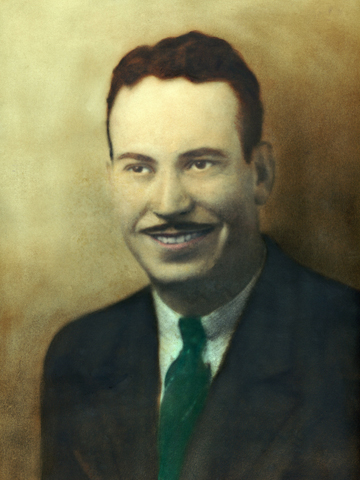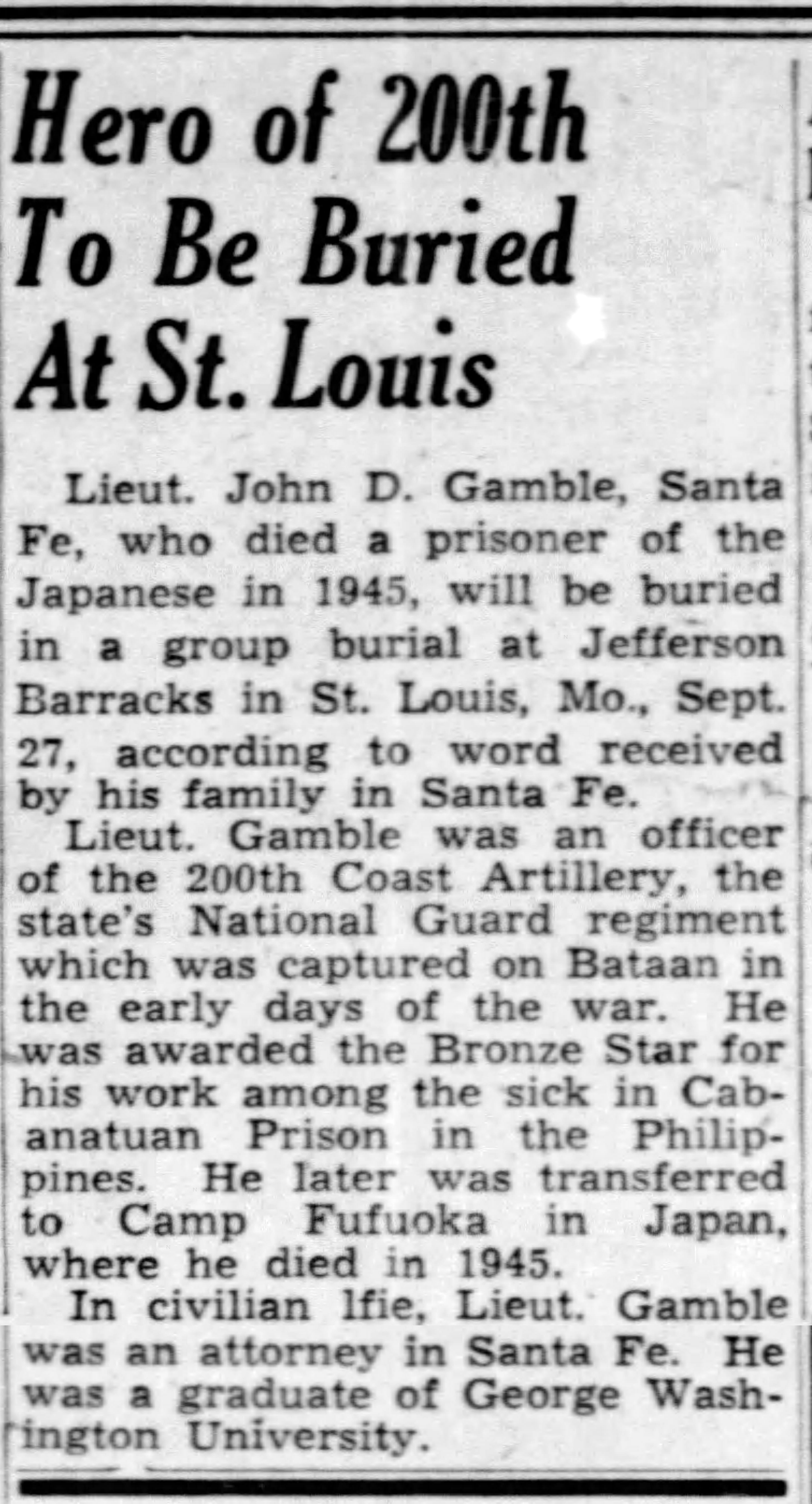2nd Lieutenant John Donald Gamble was a lawyer in Santa Fe, New Mexico, who had volunteered with other New Mexicans to serve during WWII with the 200th Coast Artillery. The 200th, whose personnel almost all spoke fluent Spanish, were chosen to go to the Philippines in the summer of 1941, and arrived in September 1941. Once there, this anti-aircraft unit was deployed to provide air defenses for Clark Field, while based at Fort Stotsenburg.
After the Japanese broke the lines in 1942, the army knew the peninsula was lost and were ordered to surrender on April 9, 1942 to the Japanese 14th Army. From here, 2LT Gamble and 12,000 fellow Americans were subjected to the inhumane Baatan Death March, with most survivors being sent to Cabanatuan Prison Camp. By 1944, the Japanese knew it was only a matter of time until the Americans would recapture the islands and they began shipping prisoners back to Japan and Manchuria. These ships became known as Hell Ships because of their horrible conditions. In a letter to John Gamble's wife, his fellow friend and POW, Fred Swope described their experience within the Hell Ships as:
"John [Gamble] and I [Fred Swope] arrived in Japan at Moji, Kyushu on January 30, 1945. There we were separated and sent to different camps. I remained at the camp at Moji. He was very sick on the boat going to Japan as you probably have learned we were bombed several times and had to abandon ship the first time and change from the second ship to a third in Formosa, we had very scant clothing and it was very cold and they gave us very little water and food. The men would die every day and night, as many as forty a day on an average of thirty. It seemed as tho the Japs wanted us to all die. There were sixteen hundred and nineteen men when we left and I don't believe that over three hundred and fifty men survived the trip."
Once arriving to Honshu Island, 2LT Gamble was transferred to the Fukuokoa POW Camp, near Fukuokoa, Kyushu, Japan. Within two weeks, after surviving the Bataan Death March, over three years in the Cabanatuan POW Camp, months aboard the Hell Ships, and the inhumane conditions at Fukuokoa, 2LT John D. Gamble died of malnutrition on February 18, 1945.
His cremated remains were initially buried with his comrades who met their death while Prisoners-of-War at Fukuoka. Prior to formal disinterment by the Americans, this communal grave was situated in the northwest corner of a civilian cemetery on the outskirts of Fukuoka city. At that time, the Japanese people practiced mass cremation in disposing of remains that were considered "inferior status," and the ashes were allowed to accumulate in one large container. Inscribed on the stake marking this plot was "Prisoners of War Communal Grave," with the date "May 1945."
This communal urn was originally transferred to the U.S. Armed Forces Cemetery in Yokohama, Japan. Later, the remains were moved and re-interred in the Jefferson Barracks National Cemetery, located at St. Louis, Missouri. Because it was impossible to identify individuals, it was not possible for 2LT Gamble to be separated from the others within the urn and returned to Santa Fe to be near his family. Today, 2LT Gamble and his comrades may be visited in a marked grave at the Jefferson Barracks National Cemetery.
In reviewing many accounts, those that knew 2LT John Gamble always reported that he was one of the finest officers that they ever knew. He was referred to as a "morale booster," always visiting the troops at the hospital, giving history lectures, and participating in theatrical productions.
On December 28, 1948, 1LT John D. Gamble was awarded posthumously the Bronze Star Medal for Meritorious Achievement in Ground Operations against the Enemy in the Philippine Islands, April 1942 - November 1944.
The Veterans of Foreign Wars have chosen to honor 1LT John D. Gamble by dedicating their Post in Los Alamos, New Mexico to his memory.
2nd Lieutenant John Donald Gamble was a lawyer in Santa Fe, New Mexico, who had volunteered with other New Mexicans to serve during WWII with the 200th Coast Artillery. The 200th, whose personnel almost all spoke fluent Spanish, were chosen to go to the Philippines in the summer of 1941, and arrived in September 1941. Once there, this anti-aircraft unit was deployed to provide air defenses for Clark Field, while based at Fort Stotsenburg.
After the Japanese broke the lines in 1942, the army knew the peninsula was lost and were ordered to surrender on April 9, 1942 to the Japanese 14th Army. From here, 2LT Gamble and 12,000 fellow Americans were subjected to the inhumane Baatan Death March, with most survivors being sent to Cabanatuan Prison Camp. By 1944, the Japanese knew it was only a matter of time until the Americans would recapture the islands and they began shipping prisoners back to Japan and Manchuria. These ships became known as Hell Ships because of their horrible conditions. In a letter to John Gamble's wife, his fellow friend and POW, Fred Swope described their experience within the Hell Ships as:
"John [Gamble] and I [Fred Swope] arrived in Japan at Moji, Kyushu on January 30, 1945. There we were separated and sent to different camps. I remained at the camp at Moji. He was very sick on the boat going to Japan as you probably have learned we were bombed several times and had to abandon ship the first time and change from the second ship to a third in Formosa, we had very scant clothing and it was very cold and they gave us very little water and food. The men would die every day and night, as many as forty a day on an average of thirty. It seemed as tho the Japs wanted us to all die. There were sixteen hundred and nineteen men when we left and I don't believe that over three hundred and fifty men survived the trip."
Once arriving to Honshu Island, 2LT Gamble was transferred to the Fukuokoa POW Camp, near Fukuokoa, Kyushu, Japan. Within two weeks, after surviving the Bataan Death March, over three years in the Cabanatuan POW Camp, months aboard the Hell Ships, and the inhumane conditions at Fukuokoa, 2LT John D. Gamble died of malnutrition on February 18, 1945.
His cremated remains were initially buried with his comrades who met their death while Prisoners-of-War at Fukuoka. Prior to formal disinterment by the Americans, this communal grave was situated in the northwest corner of a civilian cemetery on the outskirts of Fukuoka city. At that time, the Japanese people practiced mass cremation in disposing of remains that were considered "inferior status," and the ashes were allowed to accumulate in one large container. Inscribed on the stake marking this plot was "Prisoners of War Communal Grave," with the date "May 1945."
This communal urn was originally transferred to the U.S. Armed Forces Cemetery in Yokohama, Japan. Later, the remains were moved and re-interred in the Jefferson Barracks National Cemetery, located at St. Louis, Missouri. Because it was impossible to identify individuals, it was not possible for 2LT Gamble to be separated from the others within the urn and returned to Santa Fe to be near his family. Today, 2LT Gamble and his comrades may be visited in a marked grave at the Jefferson Barracks National Cemetery.
In reviewing many accounts, those that knew 2LT John Gamble always reported that he was one of the finest officers that they ever knew. He was referred to as a "morale booster," always visiting the troops at the hospital, giving history lectures, and participating in theatrical productions.
On December 28, 1948, 1LT John D. Gamble was awarded posthumously the Bronze Star Medal for Meritorious Achievement in Ground Operations against the Enemy in the Philippine Islands, April 1942 - November 1944.
The Veterans of Foreign Wars have chosen to honor 1LT John D. Gamble by dedicating their Post in Los Alamos, New Mexico to his memory.
Family Members
Sponsored by Ancestry
Advertisement
Explore more
Sponsored by Ancestry
Advertisement












